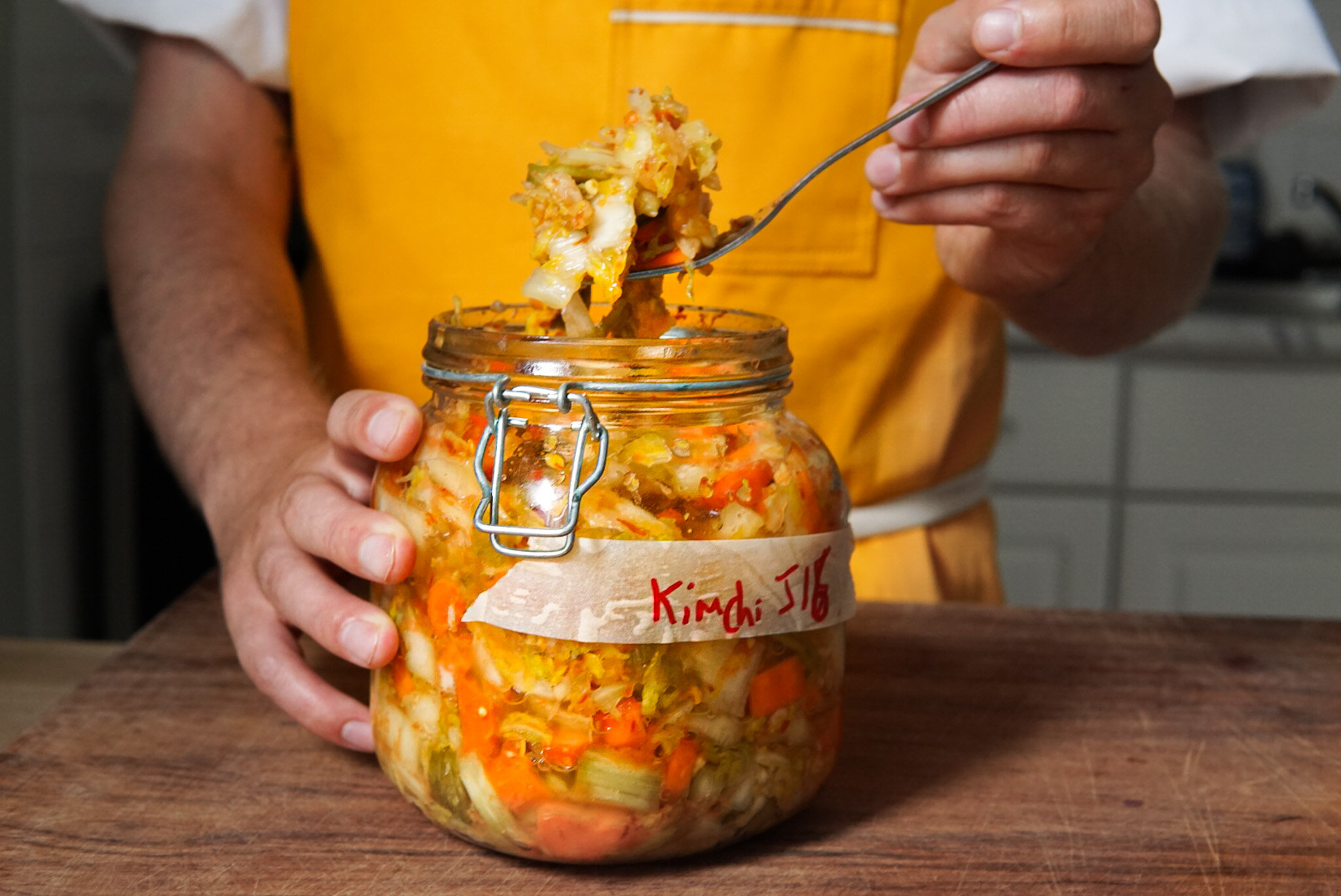This is by no means the most traditional way to make kimchi. But, this is the fastest and most straight forward method. Fermented foods can be intimidating, but this recipe isn’t. Try it out!

Ingredients
1 napa cabbage, if you can’t find it, any other cabbage will work
2% salt (weight cabbage in grams and multiply it by .02), roughly 1 tbsp
Vegan Fish Sauce
2 tbsp tamari, or soy sauce
2 tbsp brown sugar
1⁄4 pineapple juice (from a can) 1⁄4 cup warm water
Chilli Sauce
3 tbsp fresh ginger, chopped
1 head garlic, peeled and chopped
1 small white onion, chopped
1⁄2 cup Korean red chilli flake (I’ve used chilli garlic paste before, it works well if you can’t find Korean chilli flakes)
Vegetables *optional*
2 whole carrots, rated with a box grater 6 green onions, roughly chopped
Method
1. Make sure that you are using a clean surface with clean utensils, bowls and containers, 1L mason jars work well, but anything glass will really do the job! Ideally you have a container that has a wide mouth. Start by removing the outer sad looking leaves of the cabbage. Then half the cabbage, and half again, so that you have four quarters. Slice the cabbage as thin as you like. The bigger the cabbage pieces, the longer it will take to ferment. After you have sliced up all the cabbage, make sure you wash it properly. It is easiest to do in a salad spinner. If you don’t have a salad spinner, rinsing in a strainer works as well.
2. Once cabbage is properly washed, and dried, begin salting it. Place the cabbage in a bowl and add the salt. Using a clean hand or glove, massage the cabbage, keep massaging the cabbage until there is a lot of moisture released and the cabbage is soft. This will take 5-10 minutes. Set aside.
3. Prepare the vegan fish sauce by adding all the ingredients in a bowl and whisk with a fork. Set aside.
4. Chop the carrots and the green onions. Stir the veg into the cabbage.
5. Prep the chilli sauce by adding everything to a food processor and pulsing until combined. Add the vegan fish sauce and the chilli sauce to the cabbage mixture.
6. Wearing a glove, mix until well combined. Using a clean, sterilized container, start filling them with the kimchi. Making sure to push down the kimchi as much as you can when you are filling the container. Add all the liquid as well. You want the kimchi to be completely covered in liquid. The liquid will protect the vegetables from growing mold. If you are worried about this, you can purchase glass fermentation weights, or use a ziplock bag to keep everything submerged. You might need to use 2 containers. Make sure to date the container, so you can track it.
7. Set your kimchi somewhere where you will see it, the kitchen counter works best. Each day that passes, check on it, you want to ‘burp’ it every day to release some gas buildup. The time that you allow it to ferment is up to you. 1 week is typically pretty good. The longer it sits, the tangier and more tender it will become. Try it after a week and see if that’s what you like, if you want it softer, wait a few days.
8. When it gets to what you like, pop it in the fridge and it is good for 3-4 weeks. Kimchi is great in rice bowls, on nachos, or really anywhere that you are looking for a tangy, spicy kick!


